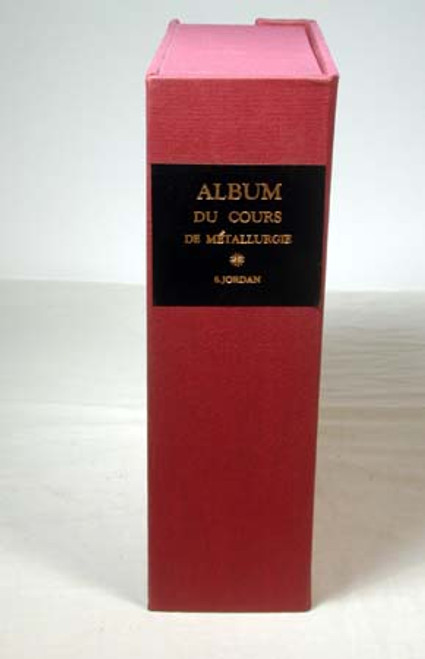Dumont, Andre, H. Von Dechen, Elie de Beaumont, et.al.; "Carte geologique de l'Europe a l'echelle du 8,000,000e, pour faciliter l'etude de la geologie generale, et pour servir au developpement des connaissances ordinaires de geographie”….A. Dumont, H. Von Dechen, Elie de Beaumont…par le Capitaine d etat,-major Hennequin Professor l’Ecole de Guerre”. Brussels, 1875. Text and folded colored geological map. Text, octavo, pp. 27. Folded colored geological map, linen backed in 18 panels, measures 31 inches wide by 26 inches.
This work is complete and inscribed on title from Hennequin to Jules Marcou with Marcou book plate on pastedown and address part of shipping label preserved on end sheet, book plate and discard stamp of AMNH on pastedown and stamp on verso of title. Text is in a contemporary calf over marbled boards with gilt spine titles. Titles rubbed, restoration to spine margins, inner hinge re-enforced. Map is loosely inserted in rear and is clean and bright. A very rare map with the accompanying text, in very good condition.
There are two Andre Dumont’s involved in the above map and this has led to confusion amongst historians of geology.
Andre Hubert Dumont, (1809-1857) was a famous Belgian geologist, known for his work on identifying and correlating the strata of Belgium. A project that took twenty years to complete and led to his publication of a famous geological map of Belgium. Andre Hubert Dumont was born in Liege, Belgium. His first work was a Memoire on the geology of the province of Liège published in 1832 and led to his becoming a professor of mineralogy and geology at the University of Liege. He soon turned his attention to the mineralogical and stratigraphical description of the geological formations in Belgium and after many years of research Dumont published a geological map of Belgium in 1849. The famous geologist Jules Marcou called Dumont’s map of Belgium “a real masterpiece of coloring”. Dumont made his work as complete as possible, examining—on foot—almost every area of importance in the country.
Dumont then started working on a geological map of Europe in which he intended to tie the geological strata and features across the boundaries of nations into one unified map. He journeyed to the more southern parts of Europe, mapped the the mountains of Spain and other regions, collecting material for his geological map of Europe. This proposed work was one of the first serious attempts to establish the regional-scale geological correlation between the various countries of Europe. As with his map of Belgium, he wished to deploy the techniques of chromolithographic printing to represent geology in vibrant color. Dumont died suddenly in 1857 before he could complete the proposed geological map of Europe. After Andre Hubert Dumont’s death the project of finishing the map of Europe apparently languished. But his son Andre Dumont (1847-1920) was also a geologist and took up the project at some point. With the assistance of others; including Dechan and Ellie de Beaumont, the map was completed. The map was seen through publication in Brussels by Général Emile Hennequin, a Professor at the l’Ecole de Guerre. He was to become Director, Institut Cartographique Militaire, Brussels, and a member of the Committee of the Société Royale Belge de Geographie, The map was published simultaneously in Brussels and Paris. While the map was printed in two locations, changes were made. The Paris printing had the map name and only A. Dumont was given credit. Those details appear in the upper right corner of the map. The shading of the colors varies from the Brussel’s printing. The Brussel’s printing which is offered, has the details on the map in the lower left corner with all those who worked on bringing the map to publication appearing in the description. Both maps contain the same number of colors but the Brussel’s printing has much stronger and brighter colors. Jules Marcou praised the map as “another fine example … far superior to the one made at the same time in Edinburgh,” the “Geological Map of Europe” by Sir Roderick Murchison and James Nicol.





















